April 3rd, 2025 | 9 min. read
The Best Downdraft Ranges and Cooktops for 2025
Best Gas Downdraft Cooktop: JennAir JGD3430GS ($2,749)
Review
There are only three brands that make downdraft cooktops: KitchenAid, JennAir, and GE.
KitchenAid and JennAir downdraft cooktops are available in 30- and 36-inch sizes. Then again, they’re essentially the same unit with a slightly different style. GE is only available in a 30-inch size.
If you had to choose one, check out the JennAir. This model features 17,000 BTU and 15,000 BTU burners for powerful cooking performance.
Its downdraft system has over 300 CFM of power. (CFM stands for Cubic Feet per Minute and measures how much air is pulled by the blower or fan.)
Key Features
- 17,000 BTU Ultra-High Output Burner: Cooks food fast with very high heat. Great for boiling or stir-frying.
- 5,000 BTU Ultra-Low Output Burner with Melt Cap: Gives very low heat. Perfect for melting or simmering.
- Brass Burners with Removable Base: Strong metal burners that last a long time and are easy to clean.
- JX3 Downdraft Ventilation System (3 Speeds): Pulls smoke and steam down into the cooktop instead of up.
- DuraFinish Protection: A tough surface that helps prevent scratches and keeps the cooktop looking new.
Pros & Cons of the JennAir JGD3430GS
Pros
✔️Strong Burners: 17,000 and 15,000 BTU burners for high-heat cooking.
✔️One of the Few Downdraft Options: Only three brands make them. JennAir offers strong performance.
✔️Available in 30- and 36-Inch Sizes: More flexibility for different kitchen layouts.
Cons
❌Takes Up Base Cabinet Space: The downdraft system reduces storage under the cooktop.
❌Weaker Than Overhead Venting: 300+ CFM is okay for light to moderate cooking but may not handle heavy smoke or grease well.
❌Higher Price: More expensive than standard gas cooktops.
Best Electric Downdraft Cooktop: JennAir JED3430GS ($2,649)
Review
This electric cooktop is similar in layout to the gas version, with four smooth-top burners.

You can often bundle it with other JennAir appliances for a better overall discount.
Electric cooktops with downdraft are often better for ventilation because they don’t create as much smoke or grease as gas.
Key Features
- JX3 Downdraft Ventilation (3 Speeds): Pulls smoke and steam down through the cooktop. No overhead vent needed.
- DuraFinish Glass Protection: Helps protect the glass surface from scratches.
- 10"/6" Dual-Choice Element: One burner fits both small and large pans.
- Color-Matched Metal Knobs: Easy-to-use knobs that match the cooktop.
- Brushed Metal Design: Smooth, modern look.
Pros & Cons of the JennAir JED3430GS
Pros
✔️Space-Saving Design: Great for open kitchens or islands without room for a hood.
✔️Dual-Choice Element: Fits more pan sizes.
✔️Premium Look and Feel: Metal knobs and sleek finish.
Cons
❌Weaker Than Overhead Venting: Like most downdrafts, it may not handle heavy smoke well.
❌Slower Heat-Up: Radiant electric takes longer to heat than gas or induction.
❌Limited Options: Few electric downdraft models available.
❌High Price for Electric: Expensive compared to non-downdraft electric cooktops.
Best Cooktop Downdraft Alternative: BEST D49M30SB ($2,550)
Review
Most built-in downdraft cooktops are outdated. They typically have weaker ventilation and smaller capture areas.
If you want better performance, consider buying a separate downdraft system that installs behind your cooktop. This setup has several advantages:
You can pick any cooktop you want.
This downdraft unit has better airflow and a larger capture area.

Most entry-level brands like GE, Bosch, and JennAir offer built-in downdrafts that only rise 6 to 10 inches.
The DM49 rises a full 18 inches for improved smoke capture.
Pro Tip: Thermador has a similar downdraft. If you're buying a Thermador appliance package, it may offer better value.
A raised, separate downdraft is a smarter option than a downdraft range because you can pair it with a more powerful cooktop.
Key Features
- Available in 30-, 36-, and 48-inch widths
- 18-inch rise for better steam and smoke capture
- 11 blower placement options
- 650 CFM internal blower (up to 1650 CFM external)
- Adjustable CFM for code compliance
- Two levels of LED lighting
- Four fan speeds
- Optional recirculating kit
Pros & Cons of the BEST D49M30
Pros
✔️18-Inch Rise: Captures more steam than lower downdrafts.
✔️High Ventilation Power: Up to 1650 CFM.
✔️Flexible Installation: 11 options for blower placement.
✔️Works with Any Cooktop: Choose your ideal gas or induction model.
✔️Adjustable CFM: Can be reduced to meet building code.
✔️LED Lighting and Fan Speeds: More visibility and control.
✔️Recirculating Kit Available: Useful if external venting isn’t an option.
Cons
❌Higher Price: $2,550 plus cost of a separate cooktop.
❌More Complex Installation: May require professional help.
❌Still Not a Full Hood: Even high-end downdrafts don’t match the performance of overhead hoods.
Best Electric Downdraft Ranges: JennAir JES1750ML and KitchenAid KSEG950ESS
If you’re shopping for a downdraft range, your only options are from JennAir and KitchenAid. They’re basically the same product with minor differences.
Both are electric, which is great for baking. But if you roast or broil often, gas still performs better.
Also, you lose the bottom storage drawer. It’s taken up by the built-in blower.
JennAir JES1750ML Review
This range looks sharp and feels premium with its metal knobs and glide rack. It includes true convection and a dual-size burner.
The downdraft works fine, but it’s still not as strong as a traditional vent.
Key Features of the JennAir JES1750ML
- True Convection: Fan helps heat move evenly across all racks.
- Downdraft Ventilation: Pulls smoke down at the cooking surface.
- Die-Cast Metal Knobs: Durable and precise.
- Glide Rack: Slides smoothly, even with heavy dishes.
- 12"/6" Dual-Choice Element: Fits small or large pans.
Pros & Cons of the JennAir JES1750ML
Pros
✔️Built-in Downdraft: No need for a hood.
✔️Even Convection Cooking: Great for baking.
✔️High-End Design: Premium knobs and smooth oven rack.
✔️Flexible Cooktop: Dual-size burner.
Cons
❌No Smart Features: No Wi-Fi or app control.
❌Fewer Cooktop Elements: Less than some other ranges.
❌Premium Price: Expensive for an electric range.
KitchenAid KSEG950ESS Review
This model includes many of the same features as the JennAir, with one bonus: a steam rack.
The 6.4 cu. ft. oven is spacious, and the cooktop includes four burners. AquaLift cleaning is easy but won’t handle heavy messes.
The downdraft still can’t match a full hood’s power.
Key Features of the KitchenAid KSEG950ESS
- Downdraft Ventilation: Pulls smoke and odors down
- Even-Heat True Convection: Circulates heat evenly
- Steam Rack: Adds moisture while cooking
- 6.4 cu. ft. Oven: Large capacity
- 4 Cooking Elements: Includes dual-size zone
Pros & Cons of the KitchenAid KSEG950ESS
Pros
✔️Built-in Downdraft: No need for a hood
✔️Even Heat: Cooks evenly across racks
✔️Large Oven: Good for multiple dishes
✔️Steam Rack: Helps keep food moist
✔️Easy Cleaning: AquaLift with low heat and no strong odor
Cons
❌No Smart Features: No Wi-Fi or air fry
❌Downdraft Performance: Still weaker than full hoods
❌Extra Kit Needed for Duct-Free Use: Sold separately
Best New Downdrafts

JennAir is using the same downdraft system in their latest cooktops.
It’s a throwback to the classic JennAir design, with the vent placed in the center. The system is made by Bora, a European manufacturer.
LG and SKS Downdraft
This concept is so advanced that it might not reach full production.
The LG and SKS version is a pop-up downdraft like Thermador’s. It stays hidden until you press a button, then rises up behind the cooktop.
Here’s the twist: it doubles as a spice rack and has cooling compartments on either side.
Impressive.
Still, because of how downdrafts work, even the most creative design won’t match the performance of an overhead hood.
Why Downdrafts Don't Work in Modern Kitchens
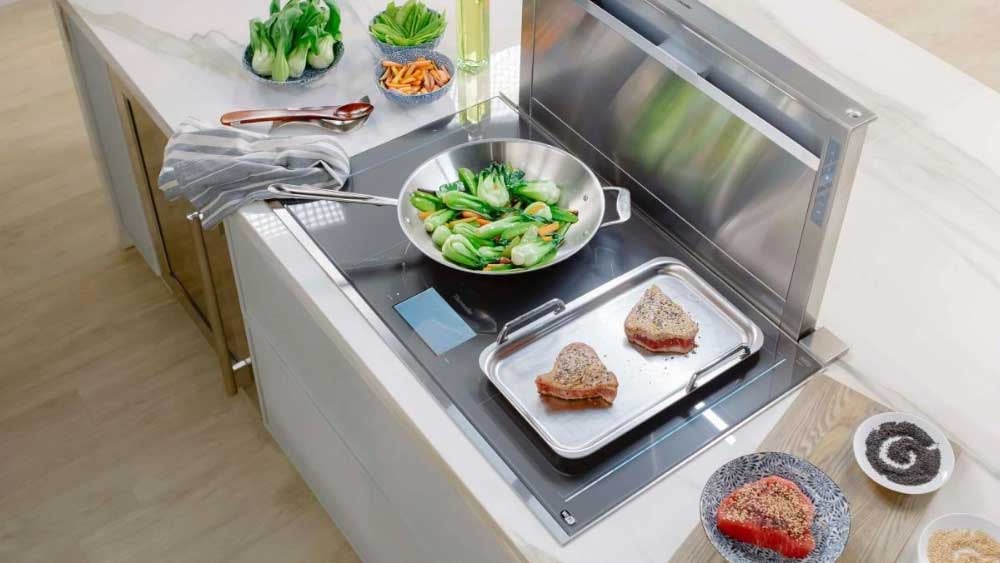
Downdrafts are number one on my list of appliances you shouldn’t buy.
If you're building a new kitchen, you should avoid downdrafts. An overhead hood is a much better option for performance, air quality, and long-term use.
Downdrafts should only be considered as a last resort, and only for existing construction where you can’t use a traditional hood.
If I knew you personally, I’d tell you to scrap the downdraft idea and renovate your kitchen instead.
Here’s why: cooking produces carbon dioxide, formaldehyde, carbon monoxide, and particulate matter.
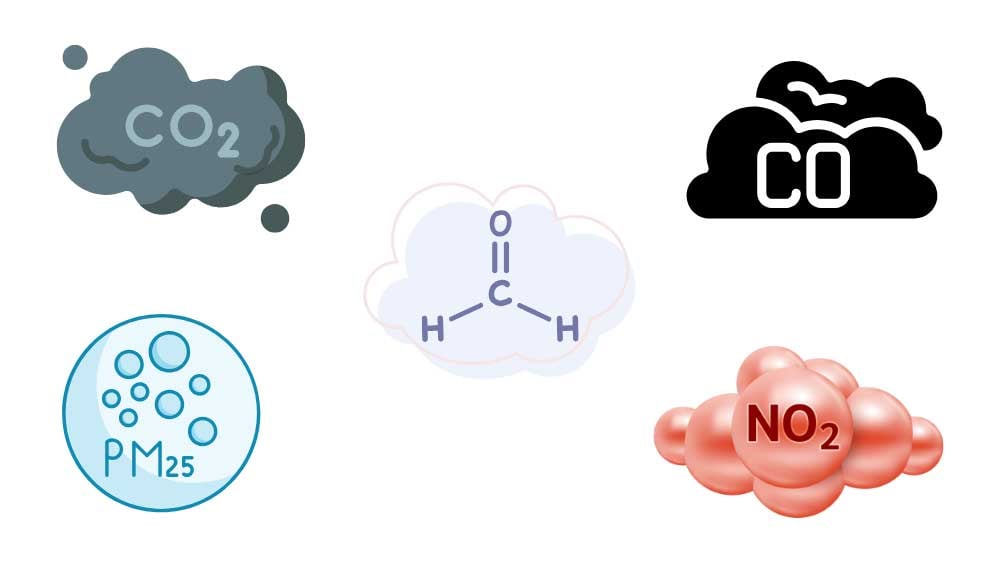
These aren't just smells - they're harmful particles that linger in your home without proper ventilation.
In this section, we’ll cover why downdrafts fall short, how they compare to other ventilation options, and what you need to know about Make-Up Air regulations.
There’s a lot to learn, and it starts with understanding how basic venting works.
If you’re unfamiliar with how to vent your kitchen, it will help to download our free Ventilation Buying Guide.
A Brief History of Downdrafts (1986–2025)
Back in 1986, downdrafts were a big trend in high-end appliances.
Brands like JennAir, Thermador, Miele, and Gaggenau all had their own versions.
My personal favorites were JennAir and especially the Thermador with its Cook N Vent downdraft.

Thermador was later acquired by Bosch in the late 1990s. The range was quickly discontinued.
JennAir followed a similar path. After being acquired by Whirlpool, its downdraft range stuck around for a while but eventually faded out.
It was discontinued in 2023 after years of being marketed under both the JennAir and KitchenAid names.
Downdraft cooktops were extremely popular for a long time. JennAir even sold their Expressions line for years before that, too, was discontinued.
And yet, somehow, downdrafts are making a comeback.
At KBIS, the industry’s biggest appliance show, they were considered some of the most innovative new products on display. But even then, you still probably shouldn’t buy one.
The Hidden Dangers of Poor Kitchen Ventilation
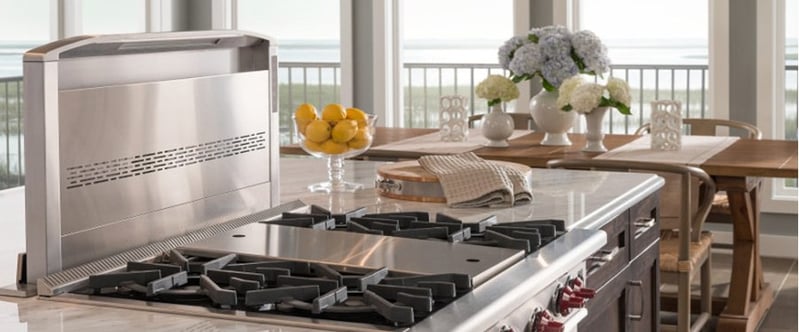 Downdraft Stationed with a High Output Gas Rangetop
Downdraft Stationed with a High Output Gas Rangetop
Stoves are way more powerful than when I started in 1986.
Even a standard gas stove now has high-output burners ranging from 19,000 to 21,000 BTUs far greater than the 6,000-8,000 BTU back in the 1980s
The problem? The downdraft sits in the back, poorly positioned to handle the most used, most powerful burners.
Energy-Efficient Homes Trap Air
.jpg?width=799&height=450&name=Thermador-Built-In-Refrigerator-Kitchen-Installation-with-Custom-Cabinets-(1).jpg)
Modern windows and building materials are designed to seal your home, which means any gases created while cooking stay inside longer.
That’s why proper kitchen ventilation is more important than ever.
The best solution you have is buying the right ventilation hood to properly exhaust the air and gases in your kitchen while cooking.
For example, in a commercial kitchen, the vent is always enormous. It is much bigger than the range to capture all the heat and smoke.
How Venting Works (And Where Downdrafts Fall Short)
Here’s how venting works, and where downdrafts come up short compared to a proper range hood:
CFM (Cubic Feet per Minute)
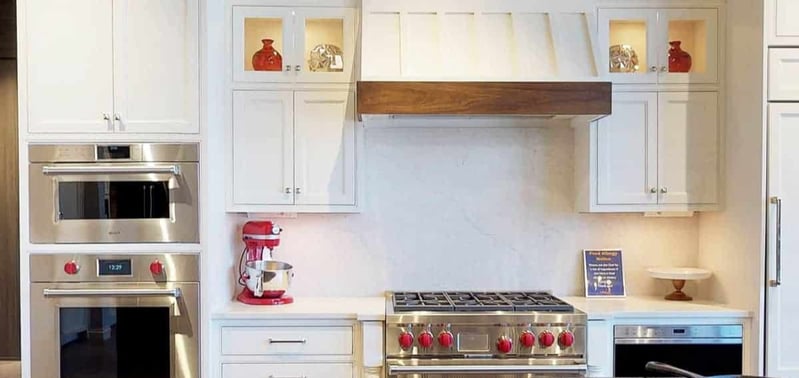
Downdrafts can technically have enough
CFM. Most range from 330 to 1500 CFM, which measures how many cubic feet of air are exhausted every minute.
But CFM alone doesn’t tell the full story.
Capture Area
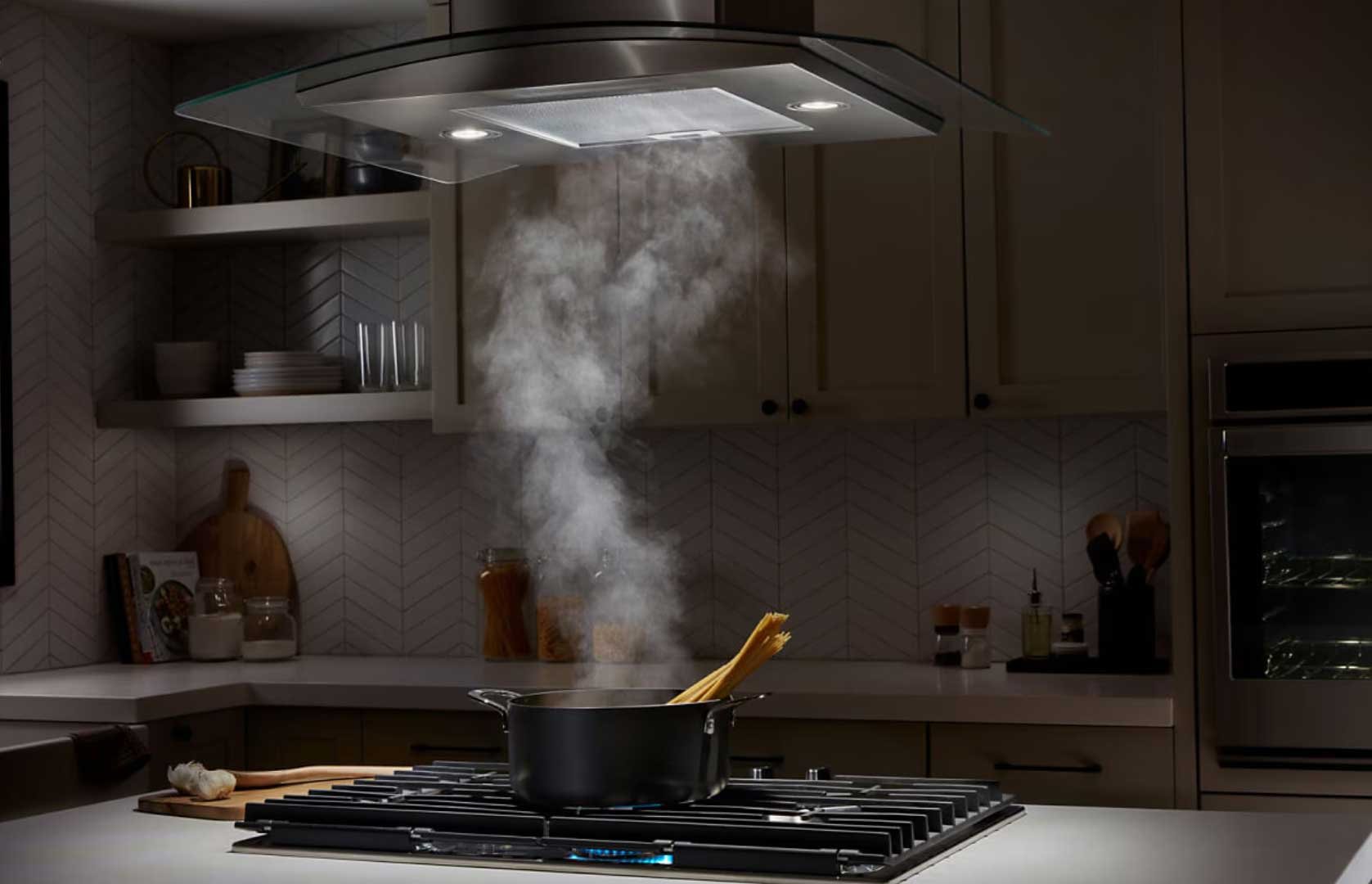
Ventilation isn’t just about airflow - it’s about capturing smoke and grease before they spread. A tall, deep range hood can trap that smoke as it rises.
A downdraft, on the other hand, has little to no capture area.
If you’re stir-frying on the front burners, that smoke will billow right past the downdraft and into your kitchen.
Duct Run
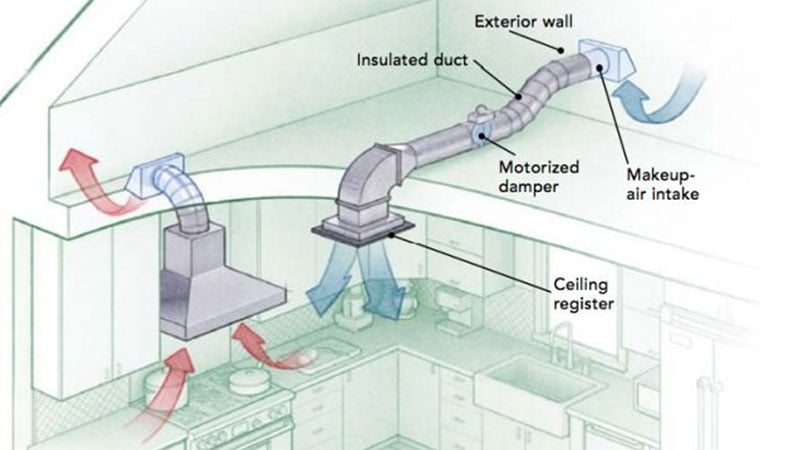
Downdrafts also reverse the natural upward flow of hot air.
That means adding bends and elbows in the ductwork, which reduces airflow and efficiency.
🔍Read more: The Ultimate Guide to Proper Kitchen Ventilation
What Is Make-Up Air (And Why It Matters)
In Massachusetts, and many other states, any new construction that uses a vent rated at 400 CFM or higher must include make-up air.
This means bringing fresh air back into your home to replace what the vent removes.
Tighter building envelopes mean that removing 400 cubic feet of air per minute can quickly create negative pressure. Air does not create a vacuum.
If there is no return system, your home will pull that replacement air from wherever it can, like your furnace, garage, or attic.

The good news is that it is easy to plan for make-up air during new construction. Usually, you just add a return to your HVAC system.
Building codes typically require the return to be placed on the opposite wall, at least 10 feet away from the vent.
But once the kitchen is finished, retrofitting that system becomes much harder and more expensive, so plan ahead.
🔍Read More: What Is Make-Up Air?
Best Downdraft Alternatives
Island Hoods
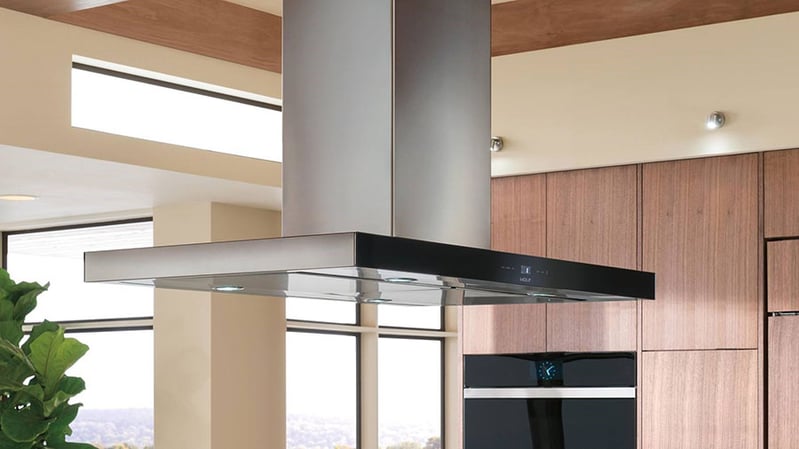
When I started at Yale, your options were limited to the Broan Chuckwagon and other equally ineffective venting solutions.
Thankfully, island hoods have come a long way. Unlike wall hoods, island hoods are finished on all four sides and come in a wide variety of styles.
You can even customize a wood hood and install a blower later.
Island hoods are worth considering because they simply capture rising air.
Unlike downdrafts, which need to pull air sideways and redirect it, hoods only manage vertical airflow.
They’re also much more effective at capturing large volumes of smoke and grease.
If possible, try to incorporate a hood before defaulting to a downdraft.
Different Kitchen Designs
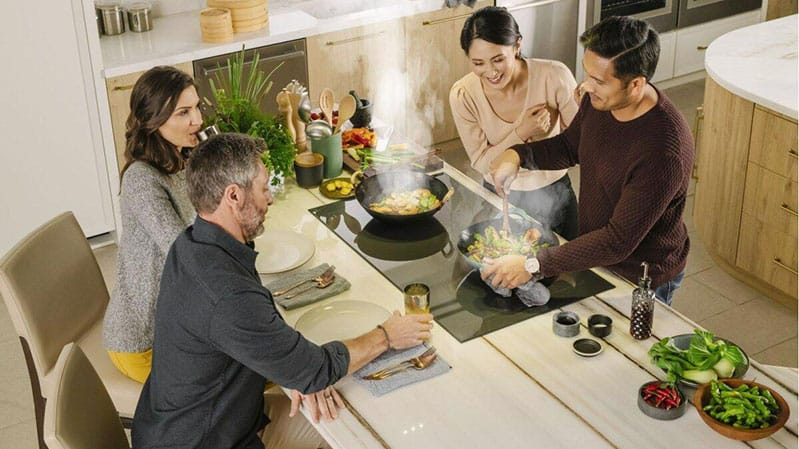
We host webinars focused on kitchen design, and we’ll include a few helpful links at the bottom.
Downdrafts aren’t ideal for ventilation in modern kitchens, but designers often favor the clean, streamlined look.
And it’s true, you probably enjoy cooking while facing your family and guests.
But functionally, that design doesn’t work well.
Instead, consider moving your most-used appliance, your sink, into the island.
Then place your cooking appliances against a wall, where you can vent directly to the outside and still maintain a stylish, practical layout.
🔍Read More: What Appliances You Should and Should Not Place in a Kitchen Island
Final Takeaways
The best advice I can give is this: do not buy a downdraft unless you're replacing an existing one.
And if you must, go with an induction cooktop, since it produces significantly less heat than gas.
We need to start taking ventilation more seriously.
Modern stoves are more powerful, and today’s tightly sealed homes trap the gases produced while cooking. That creates real health risks.
A proper hood should always be your first choice.
Even an island hood works well in the middle of the kitchen if planned correctly.
If you're limited to a downdraft, consider separating the cooktop and the downdraft system for better overall performance.
Or better yet, scrap the idea altogether and move your range against an outside wall where you can vent directly.
Downdrafts should only be used as a last resort.
Additional Resources
Download the Yale Ventilation Buying Guide with features like ducting, the proper CFM for professional ranges, downdrafts, and much more. Over 1 million people have read a Yale Guide.
Related Articles
- 4 Kitchen Hoods You Should Not Buy
- How to Choose the Best Kitchen Range and Range Hood
- How to Plan Your Kitchen Appliance Project
- 11 Kitchen Appliances You Should Never Buy
Why Should You Trust Us?
It seems that every appliance review has nothing but glowing comments about almost every product, yet you read customer reviews and they are almost universally bad.
We are here to fill in the disconnect. We'll give you the best features, and the drawbacks as well, including reliability based on over 37,000 calls performed by our service team just last year. Our goal is to give you ALL the information so you know what's right for you.
Please consider subscribing or adding to the conversation in the comments below. We appreciate you stopping by.
A Note About Pricing
Pricing on this blog is for reference only and may include time sensitive rebates. We make every attempt to provide accurate pricing at time of publishing. Please call the stores for most accurate price.
Topics:


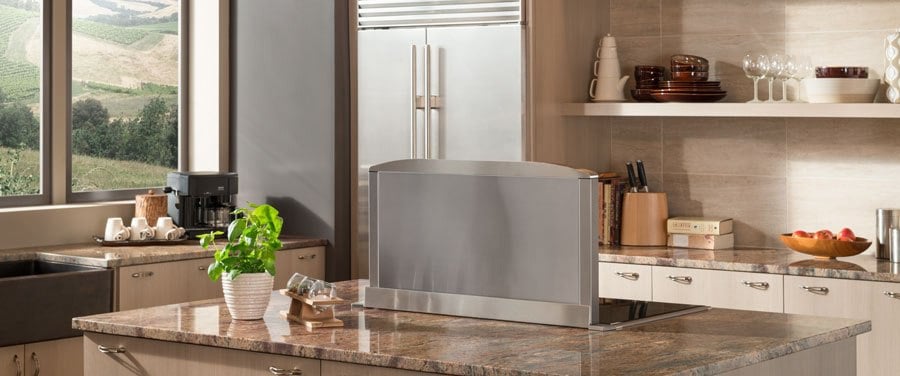
.jpg?width=730&height=411&name=Willy-Wonka-(1).jpg)






